Qualcomm Snapdragon S4 (Krait) Performance Preview - 1.5 GHz MSM8960 MDP and Adreno 225 Benchmarks
by Brian Klug & Anand Lal Shimpi on February 21, 2012 3:01 AM EST- Posted in
- Smartphones
- Snapdragon
- Qualcomm
- Adreno
- Krait
- Mobile
Power Measurements using Trepn
Measuring power draw is an interesting unique capability of Qualcomm's MDPs. Using their Trepn Profiler software and measurement hardware integrated into the MDP, we can measure a number of different power rails on the device, including power draw from each CPU core, the digital core (including video decoder and modem) and a bunch of other measures.
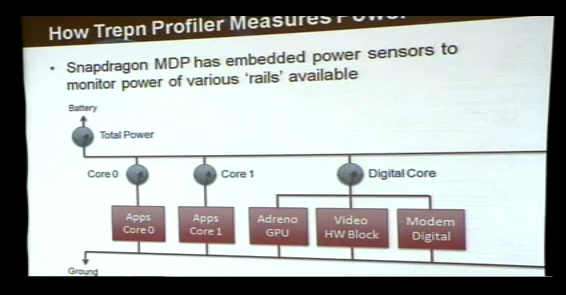
Measuring and keeping track of how different SoCs consumer power is something we've wanted to do for a while, and at least under the Qualcomm MDP umbrella at this point it's possible to measure right on the device.
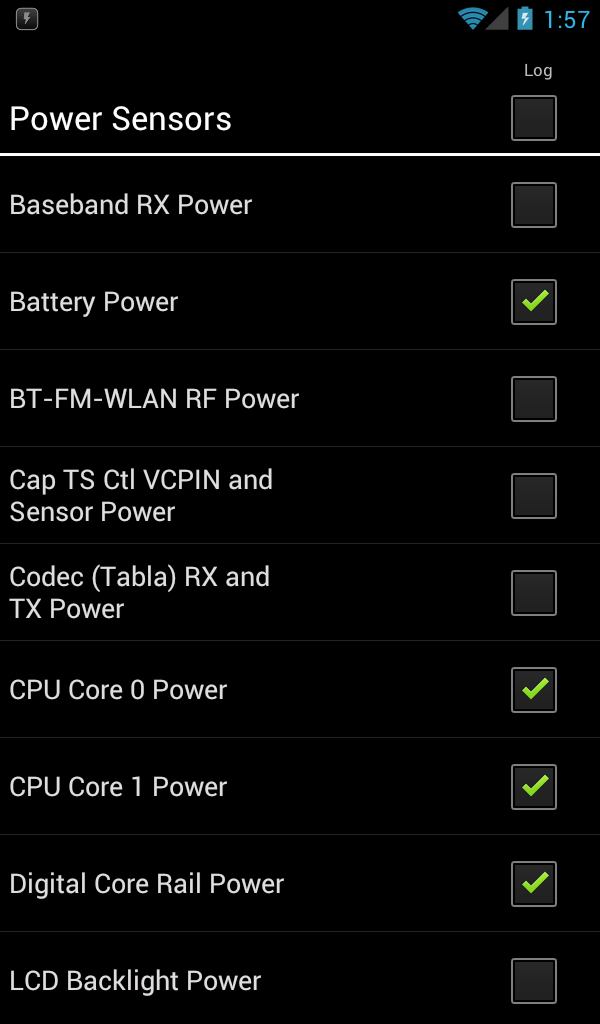
The original goal was to compare power draw on 45nm MSM8660 versus 28nm MSM8960, however we encountered stability issues with Trepn profiler on the older platform that are still being resolved. Thankfully it is possible to take measures on MSM8960, and for this we turned to a very CPU intensive task that would last long enough to get a good measure, and also load both cores so we can see how things behave. That test is the Moonbat Benchmark, which is a web-worker wraper of the sunspider 0.9 test suite. We fired up a test consisting of 4 workers and 50 runs inside Chrome beta (which is web-worker enabled), and profiled using Trepn.
If you squint at the graph, you can see that one Krait core can use around 750 mW at maximum load. I didn't enable the CPU frequency graph (just to keep things simple above) but is 750 mW number happens right at 1.5 GHz. The green spikes from battery power are when we're drawing more than the available current from USB - this is also why you see devices sometimes discharge even when plugged in. There's an idle period at the end that I also left visible - you can see how quickly Qualcomm's governor suspends the second core completely after our moonbat test finishes running.
Here's another run of moonbat on Chrome Beta where we can see the same behavior, but zoomed in a bit better - each Krait core will consume anywhere between 450 mW and 750 mW depending on the workload, which does change during our run while V8 does its JIT compilation and Chrome dispach things to each CPU.
The next big question is obviously - well how much does GPU contribute to power drain? The red "Digital Core Rail Power" lines above include the Adreno 225 GPU, video decode, and "modem digital" blocks. Cellular is disabled on the MDP MSM8960, and we're not decoding any video, so in the right circumstances we can somewhat isolate out the GPU. To find out, I profiled a run of GLBenchmark Egypt on High settings (which is an entirely GPU compute bound test) and let it run to completion. You can see how the digital rail bounces between 800 mW and 1.2 W while the test is running. Egypt's CPU portions are pretty much single-threaded as well, as shown by the yellow and green lines above.
Another interesting case is what this looks like when browsing the web. I fired up the analyzer and loaded the AnandTech homepage followed by an article, and scrolled the page in the trace above. Chrome and "Browser" on Android now use the GPU for composition and rendering the page, and you can see the red line in the plot spike up when I'm actively panning and translating around on the page. In addition, the second CPU core only really wakes up when either loading the page and parsing HTML.
One thing we unfortunately can't measure is how much power having the baseband lit up on each different air interface (CDMA2000 1x, EV-DO, WCDMA, LTE, etc.) consumes, as the MDP MSM8960 we were sampled doesn't have cellular connectivity enabled. This is something that we understand in theory (at least for the respective WCDMA and LTE radio resource states), but remains to be empirically explored. It's unfortunate that we also can't compare to the MDP MSM8660 quite yet, but that might become possible pretty quickly.


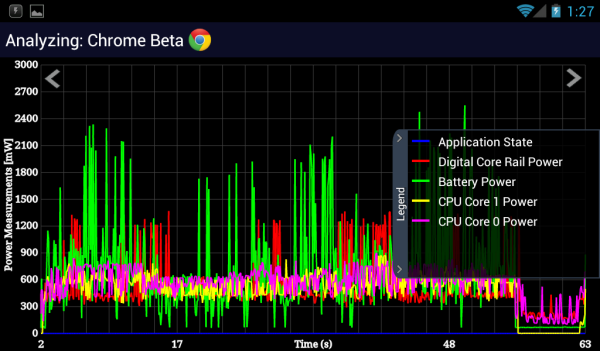
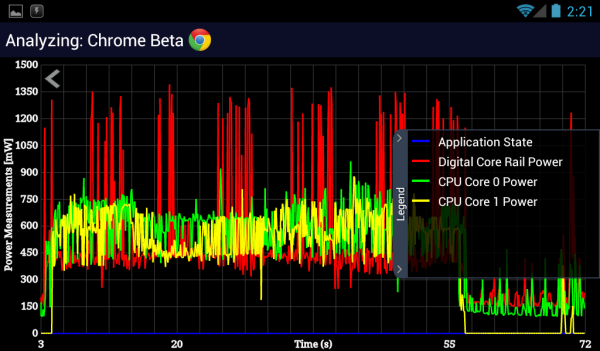
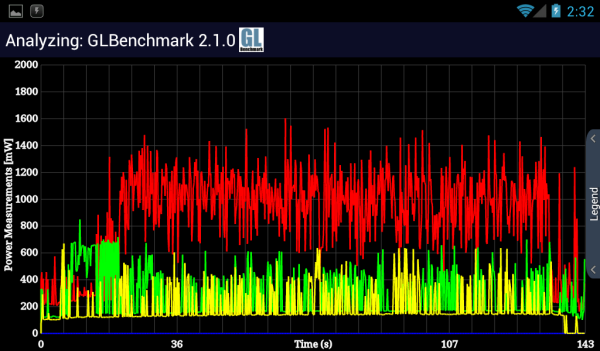
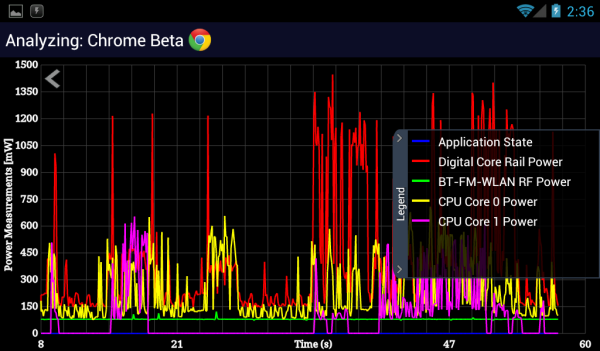








86 Comments
View All Comments
Exophase - Wednesday, February 22, 2012 - link
That 750mW is not for the entire core, it's for the CPU with hyperthreading disabled plus L2 cache. Intel said enabling hyperthreading adds some further draw to it, something between 10-20% as far as I can remember.hova2012 - Tuesday, February 21, 2012 - link
I'm pretty sure I'm not the only one who is disappointed that the Krait dual core wasn't compared to intel's upcoming atom socs. Isn't this the generation that was supposed to bring arm up to parity with intel's chip? All in all this was a great article, sets the standard for tech reviews.Exophase - Wednesday, February 22, 2012 - link
Hard to give a good comparison when you don't have direct access to Intel's reference hardware, or if you do you aren't under liberty to publish benchmarking results.Lucian Armasu - Tuesday, February 21, 2012 - link
Why are the MDP versions of Qualcomm's chips significantly higher performance than the ones in the market, like the one in the HTC Rezound? Doesn't that seem strange to you?Could it be that Qualcomm's MDP chips are meant to run significantly faster to show good benchmarks, but then they weaken them in shipping products? Or is there something I'm missing?
Death666Angel - Tuesday, February 21, 2012 - link
How would they weaken them in shipping products?Do you have more comparisons between the MDP and shipping phones apart from the Rezound?
I would look to different governor settings, different software builts and different settings as an explanation before jumping into conspiracy territory. :D
Lucian Armasu - Tuesday, February 21, 2012 - link
I was just looking at the score charts Anandtech provided. Look at these 2 for example:http://images.anandtech.com/graphs/graph5559/44380...
http://images.anandtech.com/graphs/graph5559/44383...
Why does the MDP MSM8660 have significantly higher (double) performance than the presumably "same" MSM8660 chip in HTC Rezound? Isn't the MDP MSM8660 supposed to showcase the same MSM8660 that will go into the market?
I'd love for Brian or Anand to prove me wrong here with some kind of technical explanation, but until then I'll just assume it's Qualcomm being sneaky and trying to manipulate the public's opinion about their chips.
ndk - Tuesday, February 21, 2012 - link
The article clearly mentions that MDP 8660 was running with governor settings at "performance". I can't imagine HTC or any other company shipping their products with this setting on.Brian Klug - Tuesday, February 21, 2012 - link
NDK is correct about governor being the reason, and I found that result interesting as well.It's clear to me at least that the governor settings on the Rezound are fairly conservative, and that even with a workload that's supposed to completely load both cores (mashing the multi-threaded test button in linpack pro), you never really get better that single threaded performance.
-Brian
infra_red_dude - Tuesday, February 21, 2012 - link
All the overlay customization by OEM and the power management code in the device kernel does have a detrimental effect on the device's performance.phoenix_rizzen - Tuesday, February 21, 2012 - link
Not to mention versions of Android. The MDP is running 4.0.3. What's the Rezound running?